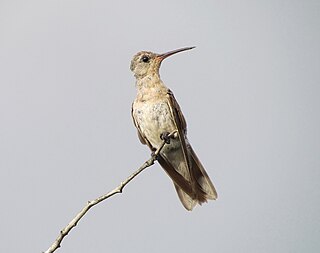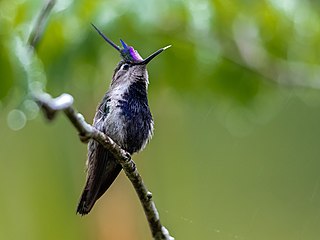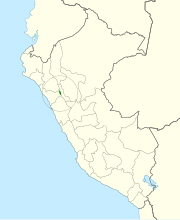
Hummingbirds are birds native to the Americas and comprise the biological family Trochilidae. With approximately 366 species and 113 genera, they occur from Alaska to Tierra del Fuego, but most species are found in Central and South America. As of 2024, 21 hummingbird species are listed as endangered or critically endangered, with numerous species declining in population.

The black-chinned hummingbird is a hummingbird occupying a broad range of habitats. Its summer range is in the western United States and southwestern Canada. It is migratory, wintering as far south as Mexico. In sunlight, the gorget of iridescent purple feathers bordering its black chin is noticeable.

Anna's hummingbird is a North American species of hummingbird. It was named after Anna Masséna, Duchess of Rivoli.

The hermits are tropical and subtropical hummingbirds in the subfamily Phaethornithinae, comprising 37 species in six genera. They occur from southern Mexico, through Central America, to South America as far south as northern Argentina.

The purple-backed sunbeam is a bird species in the family Trochilidae. It is found only in Peru.

The white-tufted sunbeam is a species of hummingbird in the family Trochilidae. It is found only in Peru. Its natural habitats are subtropical or tropical moist montane forest and subtropical or tropical high-altitude shrubland.

The shining sunbeam is a species of hummingbird in the "brilliants", tribe Heliantheini in subfamily Lesbiinae. It is found in Colombia, Ecuador, and Peru.

The black-hooded sunbeam is a species of hummingbird in the "brilliants", tribe Heliantheini in subfamily Lesbiinae. It is endemic to Bolivia.

The indigo-capped hummingbird is a species of hummingbird in the "emeralds", tribe Trochilini of subfamily Trochilinae. It is endemic to Colombia.

The hooded visorbearer is a small species of hummingbird in the family Trochilidae. Endemic to the east Brazilian state of Bahia, it is found only at higher altitudes in the Chapada Diamantina region. The species is sexually dimorphic. The male is an iridescent bronzy-green overall, with black on his crown and the sides of his head. His forehead and throat are a glittering green shading to bluish-green at the lower edge and narrowly bordered by black. The female is bronzer, with a green crown and brown sides to her head. Her throat is less colorful than the male's, and she lacks iridescence on her forehead. Both sexes have crimson tails and a narrow white breast band, the male with a brilliantly iridescent golden-orange spot in the center, at the lower edge of his gorget.

The short-tailed emerald is a species of hummingbird in the "emeralds", tribe Trochilini of subfamily Trochilinae. It is found in Colombia and Venezuela. It has also been called Poortman's emerald hummingbird.

The caribs are a genus, Eulampis, of hummingbirds in the family Trochilidae. The genus contains two species, both of which are endemic to the islands of the Caribbean. The genus name comes from the Ancient Greek word eulampēs meaning 'bright shining'.

Gould's jewelfront or Gould's brilliant is a medium-sized hummingbird in the family Trochilidae. It is found in tropical and equatorial South America. This is an uncommon species with an unusually large range compared to the other members of Heliodoxa.

The buffy hummingbird is a species of bird in the hummingbird family Trochilidae. It is the only species placed in the genus Leucippus. This bird lives in dry forest and scrubland in northern South America where it feeds on insects and the nectar, flesh, and juice of cactus fruits.

The hillstars are hummingbirds of the genus Oreotrochilus. They are native to the Andes in South America.

The green-crowned plovercrest, also black-breasted plovercrest or simply plovercrest, is a species of hummingbird in the "emeralds", tribe Trochilini of subfamily Trochilinae. It is endemic to Brazil.

The long-tailed woodnymph is a species of hummingbird in the family Trochilidae. It is found in humid forest in northeastern Brazil, where it is known from the states of Pernambuco, Alagoas, Sergipe and the northernmost Bahia. It is usually thought to be widespread, but seen at low density in its increasingly fragmented range. Its population is estimated to be around 1,000–2,500 individuals, currently in decline due to deforestation and habitat loss.

The fiery topaz is a species of hummingbird in the family Trochilidae. It has brilliant iridescent plumage and resides in northern South America, where it consumes nectar and insects.

The purple-crowned plovercrest, or violet-crowned plovercrest, is a species of hummingbird in the "emeralds", tribe Trochilini of subfamily Trochilinae. It is found in Argentina, Brazil, and Paraguay.

The blue-throated hillstar is a hummingbird found only in a small portion of the southwestern Andes in Ecuador. It was discovered in 2017.



























